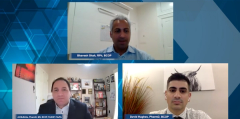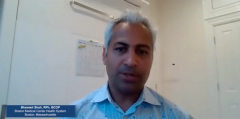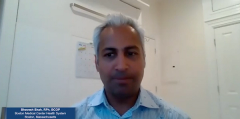
TPO-RAs as Immune Thrombocytopenia Treatment
Episodes in this series

Currently available thrombopoietin receptor agonists for relapsed immune thrombocytopenia treatment and the pros and cons of using this class of drugs vs SYK inhibitors in current practice.
Bhavesh Shah, RPh, BCOP: We talked about fostamatinib, the clinical trials supporting second-line therapy and updated guidelines, and the evidence. Now I want to change gears to TPO [thrombopoietin] receptor agonists and understand your perspectives on where TPO receptor agonists fit into treatment for ITP [immune thrombocytopenia]. Especially now having a new mechanism, are providers reaching more for the new drug, or are they still hanging on to the TPO receptor agonists? What are some of the challenges that you experience with TPO receptor agonists in patients with ITP?
David Hughes, PharmD, BCOP: Overall, we have 3 TPO receptor agonists: 2 are oral, and 1 is a subcutaneous injection. Eltrombopag and avatrombopag are the oral options and romiplostim is available as a subcutaneous injection. All of them have their own dosing schema. Eltrombopag starts at a 50-mg dose, titrated up to 75 mg.
Avatrombopag has a unique dosing schedule. It’s available only as a 20-mg tablet and the dosing starts off as a daily. Depending on the patient’s response, the dosing frequency decreases. So if the patient needs a dose decrease, the dose decreases to 3-times weekly. If the patient needs to increase dosing, it could go to 40 mg, or double dose 3-times weekly. Oftentimes, in my experience with that drug, it tends to vary patient to patient. Sometimes a drop from daily to 3 times a week may be a little variable.
Romiplostim is 1 of those drugs that if you look at the package insert, the starting dose is 1 mcg/kg once weekly. The number of patients who respond to 1 mcg is very low. Many times, in practice, we end up starting slightly higher. We know that the median response at a certain dose is right around 3 mcg/kg, so in practice, we’re usually starting a little higher than that initial package insert says.
I see 2 big risks, aside from the caveats between them. First, with the TPO receptor agonists, we see a lot of fluctuations in volatility with platelets. Patients may experience, as I said before, platelets of greater than 700,000 per mm3, greater than 1 million per mm3. Then a week or so later, those patients are going to come back and be 10,000 per mm3. You see a lot of volatility with the platelet responses.
Secondly, because of the mechanism of stimulating more platelets with the megakaryocytes, you put patients at more of a thrombotic risk. We do see patients developing blood clots on these drugs, and we need to be cognizant of it. A common consideration with oral drugs is whether they should be taken with or without food. Avatrombopag is irrespective of food restrictions. Eltrombopag has to be taken in a fasting state separated from food products, an hour before or 2 hours after eating food. Also, eltrombopag has different doses for patients of Asian descent. Those are a couple of considerations when thinking about the potential options for patients across the TPO receptor agonists.
Ali McBride, PharmD, MS, BCOP, FASHP, FAzPA: If we’re looking at the TPO receptor agonists, some other things we have to worry about for Promacta [eltrombopag] is pharmacogenomics. If a patient is of Asian descent, they have that metabolism pathway that calls for dose reduction. In fact, I’ve seen a lot of those errors early on. A consideration for the infusion of Nplate [romiplostim] is, do patients want to come back every week? David, you’ve provided a good case example of a patient and what they can and can’t do, and that’s an appropriate area too.
Those responses with TPOs vs a SYK inhibitor or rituximab are going to be varied, because for these steroids, IVIg [intravenous immunoglobulin], and rituximab, some of these are 1-time dosing schedules. Others are maintenance in those cases too. Another area that came about and fell away was the myelofibrosis. Back in 2008 or 2009, myelofibrosis was discussed early on during the approval process. That has since faded away based on newer data and other areas as well, but it has been a concurrent issue with some patients who may have disease state and may go on some of those TPOs.
We do get some questions about the myelofibrosis from time to time, depending on our team and our prescribers, so we try to dissuade any misinformation. But we’re balancing the actual utilization of a megakaryocyte, maximizing efficiency through TPO and growth factor, in this case, and then minimizing inflammatory signals with the SYK inhibitor. The question becomes: When is the actual combination going to occur? We’re all waiting for that to be simulated in conversation or in clinical trial. For those patients who are refractory and receive a benefit with TPOs, do we add on fostamatinib in some cases to address combination therapy to reduce autoimmune activation for destruction of platelets.
Bhavesh Shah, RPh, BCOP: We have this unique adverse-effect profile with 1 vs the other. We have a patient in front of us, so if they have a history of thromboembolic disorder or VTE [venous thromboembolism], you may consider not using a TPO receptor agonist because we don’t have the issue that David mentioned, where the platelet count increases to significantly higher levels. We know increases their risk of developing a VTE.
One thing a lot of folks may not be savvy to figure this out is that there’s a lot of waste. We know that a lot of drugs are on the CMS [Centers for Medicare & Medicaid Services] list of significant waste. Bortezomib is 1, and I’m not sure where romiplostim falls. But we know that the dosing is a median of 3 mcg/kg, so you can imagine that with a 70-kg patient, you’re going to have waste with every dose that you have on a weekly basis for 52 weeks. Some payers don’t pay for waste, so we’re losing revenue and may be losing revenue from 1 drug vs the other. There’s this financial toxicity component, and then there’s the clinical toxicity that you need to be aware between these agents.
Ali McBride, PharmD, MS, BCOP, FASHP, FAzPA: Bhavesh, to add to that drug waste—sorry to interrupt you, but it would behoove the company to flat-dose a syringe. So here’s your weight. Give 100 or 200 mg on these doses as you go up that dosing ladder for scale. Think about how simple that would be for home-infusion therapies. There are ideas or opportunities out there to really reduce that drug waste, but I don’t think we’ve seen that. With more of the focus on reimbursement, not just for the drug but for that drug waste part, 10% to 20% of US spending on chemotherapy is associated with drug waste based on that recent article from last year or 2 years ago. There can be some formulation changes. With the oral therapies, if you’re dosing up or dosing down, we can have some drug waste there too. But that’s a great discussion point. Thank you.
Newsletter
Stay informed on drug updates, treatment guidelines, and pharmacy practice trends—subscribe to Pharmacy Times for weekly clinical insights.



























































































































































































































